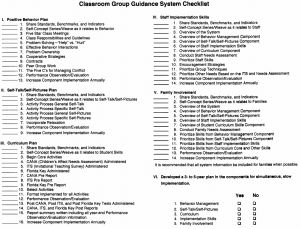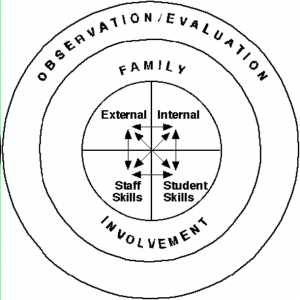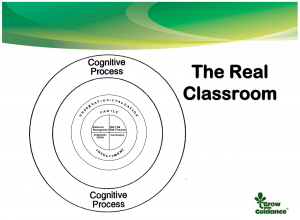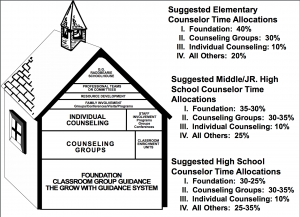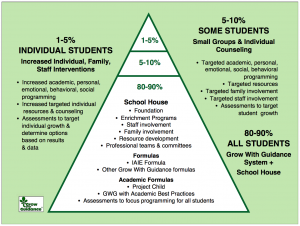The Grow With Guidance System Crosswalk With The 2019 ASCA National Model Including Mindset and Behavior Standards
Tommie R. Radd, Ph.D.
The Grow with Guidance (GWG) System is an Educational Systems Model that can be utilized by school districts wishing to incorporate school-wide systemic interventions. This document identifies general similarities and differences of the GWG Systems framework and the ASCA National Model. The goal is to assist school counselors and PreK-12 educators who would like to understand the synergy and compatibility between the GWG System and the ASCA National Model. It also provides information on how to reference the ASCA Model when implementing the GWG System. The GWG System by design creates a process grounded in multidisciplinary best practice and is integrated within the heart of the classroom and school/district. Thus, in some respects while it is congruent with the ASCA Model it is more expansive and systemic than the ASCA Model. The Grow With Guidance System includes the Educational System Foundation and the Schoolhouse Model.
It is important to discuss the title, Grow With Guidance because some consider the use of the word “guidance” to be outdated. Clarification of the use of “guidance” is essential so the innovative and progressive system framework is valued and not lost within recent perceptions of the word. The following points regarding the word “guidance” are
intended to provide a frame of reference for its use in the GWG System:
1. All professionals who have a master’s degree in School Counseling or an endorsement in school counseling and are licensed as school counselors in the state in which they work are school counselors. School counselors are leaders for the school counseling program within the school and school district. The outdated description of professional school counselors is guidance counselors. The responsibilities and training of school counselors has evolved beyond the original positions as were required in graduate programs and state licensing. The use of the word “guidance” within the Grow With Guidance System relates to System components and not the title of “school counselor.”
2. The Grow With Guidance System by design is a guidance system aligned with the concept of an interconnection of processes. The guidance system provides the dynamic needed to create the foundation of personal, social, emotional, behavioral, academic and career skills as well as experiences needed to developmentally evolve over time for lifelong learning. This could be compared to the multidimensional guidance system in a car with many moving components that interact to successfully keep the car on course. This component of the Educational System is referred to as classroom group guidance because it identifies and connects those elements needed for growth.
3. The Schoolhouse Model builds on the dynamic foundation of the educational system to provide counseling and growth opportunities to students, staff, families and stakeholders. Each Schoolhouse Component is interrelated, interdependent and interactive for program results.
The Grow With Guidance System is congruent with and exceeds all of the criteria established in the 2019 ASCA National Model and supporting documents. The Grow With Guidance System also is congruent and exceeds all of the Ohio Social and Emotional Learning Standards. Some of the key elements of the Grow With Guidance System that are important to note and are present beyond what is in the ASCA Model are the following:
1. The unique Educational System design is multidimensional and not linear. The interrelated, interdependent and interactive components of the Classroom Group Guidance System and the Schoolhouse Models are built on multidisciplinary best practice, create dynamic experiences for intrinsic growth and skill sets needed for lifelong learning.
2. The Educational Systems Model creates Life Labs, a way of defining the classroom as a simulation of experiences needed for success in all areas of life: career, personal, social, behavioral, emotional and academic. See Glossary of Terms, Teaching and Counseling for Today’s World Second Edition, page 221.
3. The Educational Systems Model includes Dynamic Change Models that chart the course for change within the school and school district. This establishes the framework for an expansive, evolving, effective and positive school climate.
4. The Educational Systems Model integrates the invitational education theory of practice within every System component. This creates a conscious and intentional plan for an inclusive, safe, supportive, democratic and inviting climate.
5. The Educational Systems Model is built upon an extensive accountability and evaluation framework as documented in the Grow With Guidance System extensive research report. The System Framework is built on standards, benchmarks, indicators and evaluation. The Children’s Affect Needs Assessment (CANA) and Invitational Teaching Survey (ITS) are both diagnostic and prescriptive assessments. Both qualitative and quantitative processes are incorporated for evaluation and accountability.
6. The Educational System Staff Implementation Skills Component is not represented in the ASCA Model. The Staff Component focuses on those skills needed by everyone in the learning community. Everyone and everything counts. There is a reciprocal relationship between what we teach and learn and our skill growth. Staff are expected to learn the skills taught to students so they can model and apply those skill experiences within the classroom life lab.
7. The Educational System Family Component is not represented in the ASCA Model. The Family Component focuses on those skills the family members need in the areas of personal, social, emotional, behavioral, academic and career. This provides family members with the ability to model and apply the skills learned in school at home.
8. The school counselor is the leader, facilitator and role model of the Educational Systems Model and Framework. The System includes the Staff Implementation Skills Component with evaluation that incorporates and expands upon many of the ASCA Professional Standards. School counselors need to be proficient in these standards in order to implement a school counseling program.
The ASCA Professional Standards identify school counselor behaviors and competencies that are not documented within the Educational Systems Model and Framework but are requirements for all school counselors who are licensed and trained as a school counselor. The mission of the Educational Systems Model and Framework is to build upon ethical and best practices within the counseling profession. This framework is not designed to be used for evaluation of any professional within the learning community. The Educational Systems Framework focuses on growth goals and plans for everyone in the learning community.
9. The Educational Systems Model and Framework does not operate in isolation as does the ASCA Model but is integrated into the heart of the classroom and school. Everyone counts and everything is identified as helpful or hurtful to the mission of the school district and the school counseling program.
10.The Educational Systems Model Framework is in alignment with effective ratios for school counselors without assignments counterproductive to best practice and counselor time priorities as is the ASCA Model. The primary difference is based on the phase-in process of the System 3-to 5-year implementation plan. It is recommended that the Foundation and Individual Counseling Components are implemented first. Then Enrichment Programs and the other Schoolhouse Components are phased in dependent on the school counselor-student ratio. The System Foundation is the school counseling program base that everything builds upon.
11.The Educational Systems Model and Framework incorporates the ASCA four quadrants, Define, Manage, Assess and Deliver, within each component of the Educational Systems Model and the Schoolhouse Model. This is demonstrated in the Schoolhouse and Classroom Group Guidance Checklists as well as in the System Framework of Standards, Benchmarks, Indicators and Performance/Evaluation.
12.The Self Concept Series and Weave is infused within every component of the Educational Systems Model and Framework and the Schoolhouse Model. The inclusion and implementation of the self-concept series and weave frames the mission, belief and communication needed to actualize that:
i.. All are valuable, able, and unique no matter what they think, say, feel or do. – Unconditional Truth.
ii. All show they are remembering that all are valuable and worth it by making helpful vs. hurtful choices toward self and others – Behavior.
iii. Each is responsible for one’s choices – Accountability.
13.The Educational Systems Model and Framework and Schoolhouse Model provide formulas to address challenges. See Teaching and Counseling for Today’s World Second Edition and System Manual for formulas for solutions to challenges we face.
14.The System Components Behavior Management and Self-Talk/ Self-Pictures connect specific activities and structure to student skill building.
15.The Grow With Guidance Curriculum Component includes a designed curriculum and curriculum framework process needed for skill building and application.
16.The Grow With Guidance System identifies those hidden barriers to growth in the Real Classroom vs. Traditional Classroom.
17.The Grow With Guidance System Standards, Benchmarks, Indicators and Evaluation connect with curriculum and a process to address each indicator. A chart of each indicator and the activities is identified.
18.The Grow With Guidance System has an organization and 3-to 5-year implementation plan.
Additional Expansion of Differences between the ASCA Model and the Grow With Guidance System are:
– Clear role of Facilitation and Communication
– Student-centered curriculum for all students
– Review and apply core skills yearly
– Curriculum built on a framework that spirals throughout system and program components
– Comprehensive observation, evaluation and accountability plan
– System based on extensive research and multidisciplinary theoretical base
– Diagnostic instruments: CANA, ITS, and Florida Key included
– Innovative role in school improvement and design
– Strong benefits for all students including: at-risk, urban, rural, those from every culture,
– and those resilient through challenges and trauma
– Positive focus on family and staff involvement
– High expectations for all within an inviting climate
– Alignment with Response to Intervention (RTI) implementation
– Integrated service learning applications within the learning community
Similarities with the Grow With Guidance System and ASCA Model
Both:
– Are Clearly Defined
– Include Accountability Plan
– Include Collaboration, Consultation, Coordination, Leadership, Advocate, Change Agent
– Include Advisory Committee
– Establish Standards
– Use Data Within the Program Plan
– Include student-counselor ratio recommendations
– Include a Define, Manage, Assess and Deliver Plan
– Assess Program Changes Annually
– Include a Program Organization Plan
See the supporting Educational System Model charts and figures below:
Grow With Guidance System Benchmark and ASCA Comparison
Grow With Guidance System Charts Including Checklist
Grow With Guidance System Schoolhouse Model, % of Time, RTI Alignment
GWG Schoolhouse Model Checklist and Sample Program Report
Alignment of the Grow With Guidance System with the ASCA Mindsets/Behavior Standards
(Note: The Grow With Guidance Systems, benchmarks, & Indicators are in the charts that follow point 2.)
| Content Area | ASCA Mindsets and Behaviors for Student Success (ASCA, 2019) | Grow with Guidance System©Benchmarks and Indicators |
| Personal Emotional Behavioral Social (PEBS) SELF | Students will:
|
Self-Indicators -Students will:
|
| OTHER AWARENESS | Students will:
|
Other Awareness Indicators -Students will:
|
| SELF-CONTROL | Students will:
|
Self-Control Indicators-Students will:
|
| DECISION-MAKING PROBLEM-SOLVING | Students will:
|
Decision-Making/Problem-Solving Indicators –Students will:
|
| GROUP COOPERATION | Students will:
|
Group Cooperation Indicators -Students will:
|
| ACADEMIC | Students will:
|
Academic Indicators -Studentswill:
|
| CAREER | Students will:
|
Career Indicators -:Students will:
|
The Grow With Guidance System Charts From Classroom To The Design Model
Classroom Group Guidance System Checklist
The Grow With Guidance System Schoolhouse Checklist and Sample Program Report
Schoolhouse Checklist, Grow With Guidance System Manual, Page 215-216
Initially prioritize Program Organization, the Foundation, and Individual Counseling. Add the other components as the foundation and organization are in place.
I. Program Organization
1. Establish district profile and statistics information such as attendance, graduation rate, retention rate, etc.
2. Meet with appropriate administrators at both the building and district level.
3. Discuss program implementation priorities for the school year.
4. Begin the year with the Foundation and continue to add schoolhouse components as the Foundation is established.
5. Establish meeting dates with the staff for the beginning of the year and throughout the year.
6. Prioritize program development in stages.
7. Establish a school or district advisory committee.
8. Develop program policies and guidelines.
9. Develop program standards, benchmarks, indicators, and performance action plans.
10. Develop program evaluation and accountability plan and reporting.
11. Develop program 3- to 5-year implementation plan.
12. Establish Teacher/Administrator Consultation.
13. Establish role in school improvement and planning.
14. Conduct building research and publish the results within the district.
15. Develop a Public Relations plan including communication through newsletters and positive newspaper articles.
16. Partner with all populations and stakeholders.
17. Develop a plan to implement invitational education concepts.
18. Give the Invitational School Survey to assess school climate.
19. Organize the program with the time percentages recommended.
20. Write and submit a report of performance results.
21. Other
II. Foundation
1. Use The Classroom Group Guidance Checklist in Chapter 4.
2. Implement The Grow With Guidance® System Levels.
3. Apply Table 5.1 for the Real and Traditional Classroom in Chapter 5.
4. Conduct the building organization meeting.
5. Implement the observation/evaluation plan for each class, building, and district.
III. Individual Counseling
1. Conduct the building organization meeting.
2. Develop standards, benchmarks, indicators, and performance action plans for the component and each group, students, staff, and families.
3. Establish a referral process for students, families, and staff.
4. Use the counseling format for individuals.
5. Integrate the concepts of invitational education.
6. Incorporate the self-concept series and weave.
7. Develop an observation/evaluation plan for each student and the component.
IV. Counseling Groups
1. Conduct the building organization meeting.
2. Develop standards, benchmarks, indicators, and performance action plans for the component and each group, students, staff, and families.
3. Develop a group referral process.
4. Use the counseling format for the group.
5. Integrate the concepts of invitational education.
6. Incorporate the self-concept series and weave.
7. Develop an observation/evaluation plan for each group and the component.
V. Classroom Enrichment Units
1. Conduct the building organization meeting.
2. Develop standards, benchmarks, indicators, and performance action plans for the component and each unit.
3. Select the classroom enrichment unit for the school.
4. Establish the community resources that can conduct the unit.
5. Determine a date to train the staff. Schedule the unit.
6. Integrate the concepts of invitational education.
7. Incorporate the self-concept series and weave.
8. Develop an observation/evaluation plan for the program and the component
VI. Staff Involvement
1. Conduct the building organization meeting.
2. Give the Staff Needs Assessment and the Invitational Teaching Survey.
3. Develop standards, benchmarks, indicators, and performance action plans for the component and each group.
4. Integrate the concepts of invitational education.
5. Incorporate the self-concept series and weave.
6. Develop an observation/evaluation plan for each program and the component.
VII. Family Involvement
1. Conduct the building organization meeting regarding family involvement.
2. Conduct parent groups and programs.
3. Work with the parent organization affiliated with your school.
4. Develop standards, benchmarks, indicators, and performance action plans for the component and each program.
5. Integrate the concepts of invitational education.
6. Incorporate the self-concept series and weave.
7. Develop an observation/evaluation plan for each program and the component.
VIII. Resource Development
1. Conduct the building organization meeting regarding resources.
2. Develop standards, benchmarks, indicators, and performance action plans for the component.
3. Network with local agencies and other community groups.
4. Integrate the concepts of invitational education.
5. Incorporate the self-concept series and weave.
6. Develop an observation/evaluation plan.
IX. Professional Teams and Committees
1. Conduct the building organization meeting.
2. Develop standards, benchmarks, indicators, and performance action plans for the component.
3. Prioritize teams and committees for participation.
4. Integrate the concepts of invitational education.
5. Incorporate the self-concept series and weave.
6. Develop an observation/evaluation plan.
The Grow With Guidance System Manual, Page 217-219
SAMPLE REPORT
AN ELEMENTARY GUIDANCE PROGRAM
Program Evaluation
An Elementary Guidance Program is developmental and proactive in its focus on what all students should know, understand, and be able to do. Annual evaluations of the program indicate that the program effectively helps students understand themselves, understand others, get along in groups, use decision-making skills, use self-control, and think about future careers. The data collected include surveys of students, parents, and staff and a pre/post administration of the Children’s Affect Needs Assessment (CANA).
The CANA is an evaluation instrument which measures students’ perceptions of self in five strands out of Grow With Guidance curriculum: self-awareness, other awareness, decision-making/problem-solving, self-control, and group cooperation. This assessment if administered as a pre and post measure to students in grades two through six. During the 1995-1996 and 1996-1997 school years, comparisons of the pre and post measure indicate the following:
1. School year – 1995-1996
a. Students showed positive growth in all five strands of the curriculum and in the
total score. There was a statistically significant change in Other Awareness, SelfControl, and the total composite score.
2. School year – 1996-1997
a. Students showed positive growth in all strands of the curriculum and there was a statistically significant gain in four strands and in the total score.
These scores indicate that students are growing and changing due to participation in the guidance program. (See attached CANA reports).
Additional evaluation of the program gathers data from parents, staff, and students. Students in grades two through six complete a survey which asks questions about how they perceive the guidance program. Questions two and six directly relate to how students apply what they are learning:
2. Have you used what you learned in Guidance outside of class?
a. 63% of the students responded “Yes”
6. Do you think about what will happen before you make a decision?
a. 68% of the students responded “Yes”
When asked to elaborate on helpful choices, typical student responses include:
“I help my mom more.”
“I was nice to other people even if my friend didn’t like them.”
“When someone got mad at me, I left him alone.”
“I don’t argue as much.”
“I am trying to get better at things I’m not as good at.”
“I am thinking more about consequences.”
“I don’t hang around with kids who do bad things.”
“I got good grades.”
Three hundred four parents responded to the 1996-1997 guidance program survey. The question which most indicate that students are applying what they learn in guidance is, “Does your child talk with you about guidance activities?” Of the parents responding, 66% indicated that their child/children do talk with them about classroom guidance.
Parent comments are very supportive of the program:
“The guidance services in our building are very beneficial to help students with social/academic skills needed as a member of our society.”
“All staff should participate in the guidance program and use the language of social skills and choices.”
“The guidance program is an excellent program and it is very appreciated and very helpful to our children.”
“We appreciate knowing that the children are learning and try to help them use the skills at home.”
Other information from the parent survey indicates that more than half of the parents have communicated with the counselor about their children and are aware of classroom guidance, small group guidance, and individual counseling services.
Teachers also complete an annual evaluation of the guidance program. Information from the survey indicates that 85% of the elementary teachers are aware of guidance materials and techniques that can be used in the classroom. As teachers become more involved in guidance lessons, they are better prepared to help students apply the skills and concepts during the week and all staff develop a common vocabulary, improve school climate, and increase positive interactions.
Teachers also indicate that guidance activities are effective in making students more aware of their own behaviors and feelings. The 1996-1997 survey indicated that 93% of the teachers observe that students are more aware of feelings and behaviors. This awareness is a critical component in changing behavior.
Ninety-five percent of the elementary teachers indicate that guidance has a positive effect on school climate. The survey indicated that through student and teacher participation in the guidance program, students perceived teachers as more personally and professionally inviting in their teaching practices. This is consistent with data from an Invitational Teaching Survey (ITS) which was administered at our elementary school
as part of a pilot survey using the Grow With Guidance System.
Information from the evaluation program is used to assess the needs of students, monitor the impact of the program on student learning and development, and to ensure that the District students are developing the skills necessary to be successful in life. Our program is consistent with the new National Standards for School Counseling Programs in supporting the educational mission of school. We continue to assess the quality of the
program and needs of students in an effort to provide the best possible program for our students.
The guidance program in the District Learning Community continues to be an exemplary model of a systems approach to creating effective and inviting schools. Maintaining a quality program which promotes academic success for our students is a priority. Therefore, we have taken the following steps to ensure continued progress and success:
• All teachers who are new to the school district are trained in the basic components of the Grow With Guidance® System.
• There is ongoing evaluation of the program and results of the evaluation are utilized in planning for additional implementation.
• School counselors and classroom teachers work as a team in facilitating student skill development in the affective domain.
• Class meetings have been implemented to support the goal of creating democratic/inviting classrooms where students practice problem-solving skills and relationship skills.
• Parents receive continuous information about the guidance program and skills which can be practiced both at school and at home.
The demographics of the school district continue to change: more student mobility, increase in number of students who qualify for free/reduced lunch, more option students who meet criteria for special services. However, standardized test scores continue to not only remain constant, but improve.

